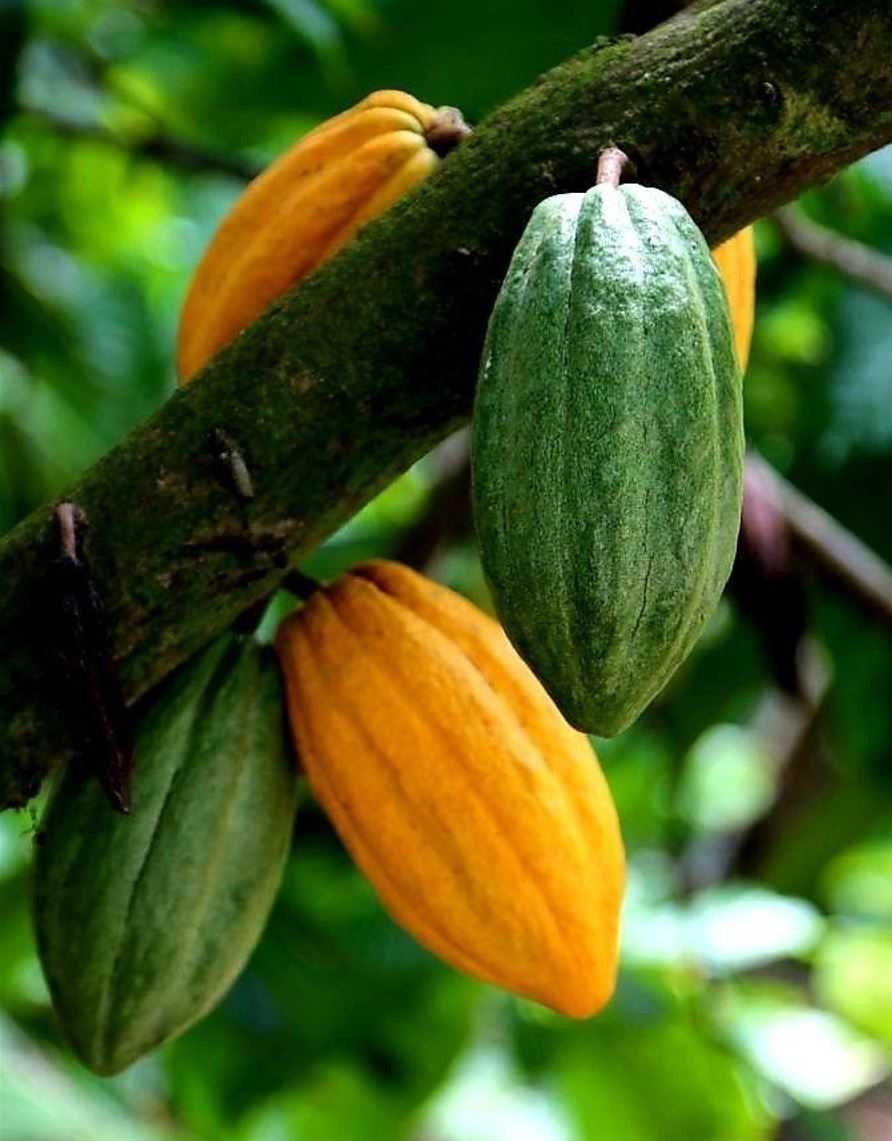Cocoa, also known as cacao, is a beloved and versatile ingredient that is derived from the seeds of the cacao tree (Theobroma cacao). Here are some fascinating aspects and uses of cocoa.
Species or types of Cocoa
There are three main species of cocoa that are cultivated for the production of chocolate and cocoa-based products. These species are as follows:
- Theobroma cacao: The most widely cultivated and economically important species of cocoa is Theobroma cacao, also known as the cacao tree. This species is native to the Amazon basin and has been cultivated for thousands of years for its seeds, which are used to make cocoa powder, cocoa butter, and chocolate products. Theobroma cacao trees thrive in tropical regions within 20 degrees of the equator and require specific growing conditions to produce high-quality cocoa beans.
- Theobroma bicolor: Theobroma bicolor, also known as the Mocambo tree, is another species of cocoa that is cultivated for its seeds. This species is native to Central and South America and produces seeds with a unique flavor profile. While not as commonly grown or commercially important as Theobroma cacao, Theobroma bicolor is valued for its contribution to the diversity of cocoa flavors and products.
- Theobroma grandiflorum: Theobroma grandiflorum, commonly known as cupuaçu, is a related species to cocoa that is native to the Amazon rainforest. While not a true cocoa species, cupuaçu is often referred to as “theobroma grandiflorum cocoa” due to its similarities in taste and usage. Cupuaçu seeds are used to produce a creamy, aromatic butter that is used in confectionery and cosmetic products.
These three species of cocoa each have unique characteristics and flavor profiles that contribute to the diversity of cocoa-based products available in the market. Theobroma cacao remains the most widely cultivated and utilized species for chocolate production, while Theobroma bicolor and Theobroma grandiflorum offer distinct flavors and applications that add variety to the world of cocoa and chocolate.
Uses of Cocoa
Cocoa is a versatile ingredient that is widely used in various culinary, nutritional, cosmetic, and cultural applications. Here are some of the common uses of cocoa:
- Chocolate Production: One of the most well-known uses of cocoa is in the production of chocolate. Cocoa beans are processed to extract cocoa mass, cocoa butter, and cocoa powder, which are key ingredients in making chocolate bars, truffles, and other confectionery products.
- Baking: Cocoa powder is a popular ingredient in baking and is used to add rich chocolate flavor to a wide range of desserts such as cakes, brownies, cookies, and muffins. It is also used in making chocolate frosting, fillings, and ganache.
- Hot Beverages: Cocoa powder is commonly used to make hot cocoa or hot chocolate drinks, which are enjoyed for their comforting and indulgent taste, especially during colder months.
- Health and Nutrition: Cocoa is rich in antioxidants and flavonoids, which have been linked to various health benefits such as improved heart health, reduced inflammation, and enhanced brain function. Dark chocolate with high cocoa content is often recommended for its potential health-promoting properties.
- Skincare: Cocoa butter, a natural fat derived from cocoa beans, is a popular ingredient in skincare products due to its moisturizing and nourishing properties. It is commonly found in lotions, creams, lip balms, and other beauty products.
- Beverage Flavoring: Cocoa is used to flavor a wide range of beverages, from milkshakes and smoothies to coffee drinks like mochas and lattes. It adds a rich and indulgent chocolatey taste to these beverages.
- Cultural and Ritual Uses: Cocoa has a long history of cultural significance, particularly among indigenous Mesoamerican civilizations like the Aztecs and Mayans, who considered cacao a sacred and valuable commodity. Today, cocoa continues to play a role in various cultural traditions and rituals around the world.
- Aromatherapy: The rich, comforting scent of cocoa is sometimes used in aromatherapy to create a relaxing and soothing atmosphere. Cocoa-scented candles, essential oils, and bath products are popular choices for those seeking a warm and indulgent fragrance.
Health Benefits of Cocoa
Cocoa offers a range of potential health benefits due to its rich content of antioxidants, vitamins, minerals, and other bioactive compounds. Here are some of the health benefits associated with cocoa consumption:
- Antioxidant Properties: Cocoa is a potent source of antioxidants, such as flavonoids and polyphenols, which help combat oxidative stress and reduce inflammation in the body. These antioxidants may contribute to overall health and well-being.
- Heart Health: Consuming cocoa and dark chocolate in moderation has been linked to improved heart health. Flavonoids in cocoa may help lower blood pressure, improve blood flow to the heart and brain, and reduce the risk of heart disease.
- Brain Function: The flavonoids in cocoa have been shown to have potential benefits for brain health. They may help improve cognitive function, enhance mood, and protect against age-related cognitive decline.
- Mood Enhancement: Cocoa contains compounds that can have a positive impact on mood and mental well-being. Eating dark chocolate or drinking cocoa may help boost serotonin levels in the brain, which can promote feelings of happiness and relaxation.
- Skin Health: Cocoa butter, derived from cocoa beans, is a popular ingredient in skincare products due to its moisturizing and nourishing properties. It helps hydrate the skin, improve elasticity, and protect against damage from environmental factors.
- Weight Management: While cocoa itself is low in sugar and calories, dark chocolate with high cocoa content can be a satisfying treat that may help curb cravings and promote feelings of fullness. Consuming dark chocolate in moderation as part of a balanced diet can support weight management efforts.
- Blood Sugar Regulation: Some studies suggest that cocoa and dark chocolate may help improve insulin sensitivity and regulate blood sugar levels, which can be beneficial for individuals with diabetes or those at risk of developing the condition.
- Anti-Inflammatory Effects: The flavonoids in cocoa have anti-inflammatory properties that may help reduce inflammation in the body and protect against chronic diseases associated with inflammation, such as arthritis and heart disease.



